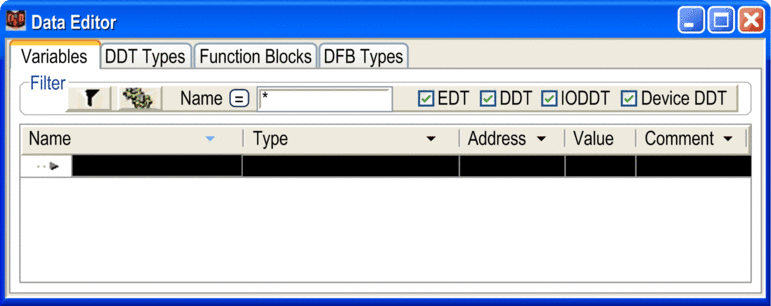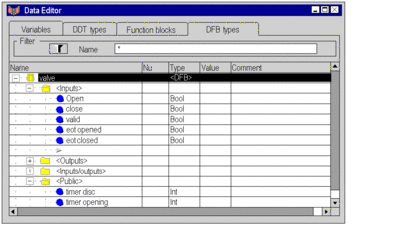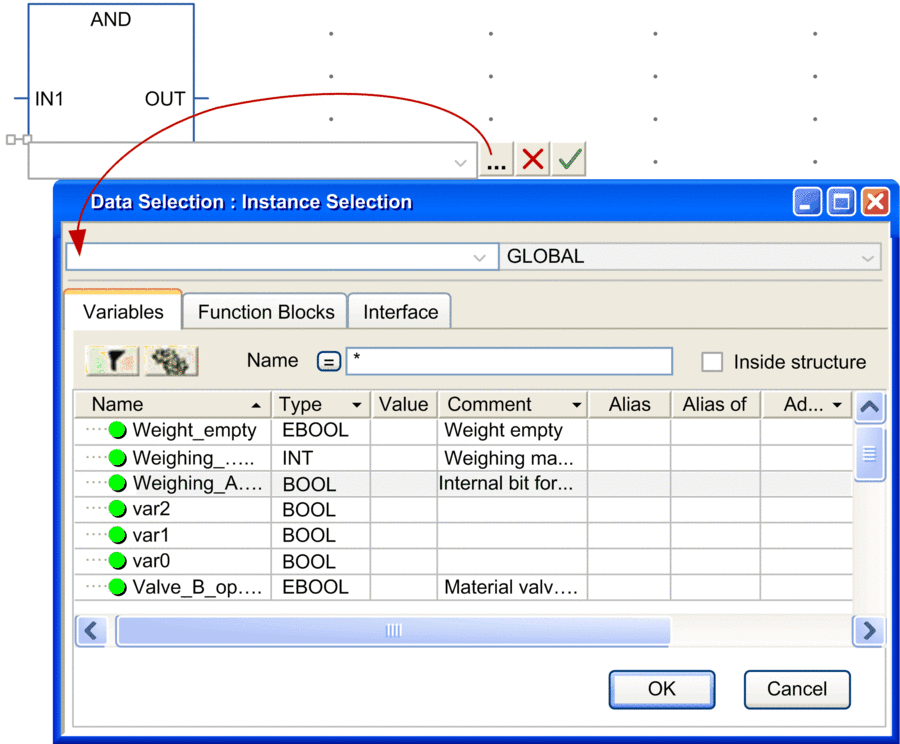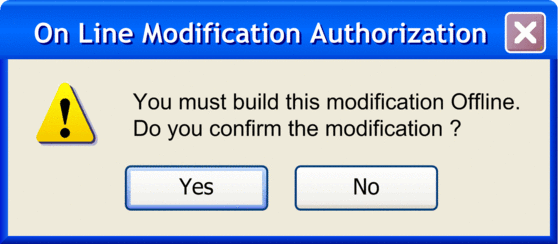Introduction
The data editor offers the following features:
Declaration of variable instances
Definition of derived data types (DDTs)
Definition of Device derived data types (Device DDTs)
Instance declaration of elements and derived function blocks (EFBs/DFBs)
Definition of derived function block (DFBs) parameters
The following functions are available in all tabs of the data editor:
, , with the following restrictions:
menu command is greyed in every tabs.
Right-click on a variable is greyed in every tabs
and menu commands are not greyed but are not working in and tabs.
Right-click and right-click on a variable are greyed in , , and tabs.
Expand/collapse structured data
Sorting according to Type, Symbol, Address etc.
Filter
Inserting, deleting and changing the position of columns
Drag and Drop between the data editor and the program editors
Undo the last change
Export/Import
Variables
The tab is used for declaring variables.
Variables tab:

The following functions are available:
Defining a symbol for variables
Assigning data types
Own selection dialog box for derived data types
Assignment of an address
Automatic symbolization of I/O variables
Assignment of an initial value
Entering a comment
View all properties of a variable in a separate properties dialog box
Hardware Dependent Data Types (IODDT)
IODDTs are used to assign the complete I/O structure of a module to an individual variable.
Assignment of IODDTs:

The following functions are available:
Complete I/O structures can be assigned with individual variables using IO DDTs
After entering the variables addresses, all elements of the structure are automatically assigned with the correct input/output bit or word
Because it is possible to assign addresses later on, standard modules can be simply created whose names are defined at a later date.
An alias name can be given to all elements of an IODDT structure.
Hardware Dependent Device Derived Data Types (Device DDT)
Device derived data type (DDT) is a predefined DDT that describes the I/O language elements of an I/O Module. This data type is represented in a structure, which depends on the capabilities of the I/O module.
This structure provides bits and register views when both extracted bits and register exist in IODDT. In this case extracted bit is not seen as a child element of the register variable but directly as field of Device DDT structure.
When adding a Modicon M340 module in a M340 remote I/O drop the Control Expert software will create automatically
the associated Device DDT instance. This instance is deduced from
IODDT (other not mapped object like %KW are not accessible).
Each I/O Module is associated with one implicit device DDT instance:
Implicit Device DDT instances are created by default on device insertion and refreshed automatically by the PLC. They contain the modules status, modules and channels health bits, values of the modules inputs, values of the modules outputs, etc.
The Implicit Device DDT can be:
linked to a device (Managed)
not linked to a device (Un-managed)
READ_STS_QX, WRITE_CMD_QX).Derived Data Types (DDT)
The tab is used for defining derived data types (DDTs).
A derived data type is the definition of a structure or array from any data type already defined (elementary or derived).
Tab :

The following functions are available:
Definition of nested DDTs (max. 15 levels)
Definition of arrays with up to 6 dimensions
Assignment of an initial value
Assignment of an address
Entering a comment
Analysis of derived data types
Assignment of derived data types to a library
View all properties of a derived data type in a separate properties dialog box
An alias name can be given to all elements of a DDT structure or an array.
Function Blocks
The tab is used for the instance declaration of elements and derived function blocks (EFBs/DFBs).
Tab :

The following functions are available:
Display of the function blocks used in the project
Definition of a symbol for the function blocks used in the project
Automatic enabling of the defined symbols in the project
Enter a comment about the function block
View all parameters (inputs/outputs) of the function block
Assignment of an initial value to the function block inputs/outputs
DFB Types
The tab is used for the defining derived function block (DFBs) parameters.
The creation of DFB logic is carried out directly in one or more sections of the FBD, LD, IL or ST programming languages.
Tab :

The following functions are available:
Definition of the DFB name
Definition of all parameter of the DFB, such as:
Inputs
Outputs
VAR_IN_OUT (combined inputs/outputs)
Private variables
Public variables
Assignment of data types to DFB parameters
Own selection dialog box for derived data types
Assignment of an initial value
Nesting DFBs
Use of several sections in a DFB
Enter a comment for DFBs and DFB parameters
Analyze the defined DFBs
Version management
Assignment of defined DFBs to a library
Data Usage
Data types and instances created using the data editor can be inserted (context dependent) in the programming editors.
The following functions are available:
Access to all programming language editors
Only compatible data is displayed
View of the data according to their scope affiliation
View of the functions, function blocks, procedures and derived data types arranged according to their library affiliation
Instance declaration during programming is possible
Data selection dialog box:

Online Modifications
It is possible to modify the type of a variable or a Function Block (FB) instance declared in application or in a Derived Function Block (DFB) directly in online mode. That means it is not required to stop the application to perform such a type modification.
These operations can be done either in the data editor or in the properties editor, in the same way as in offline mode.
When changing the type of a variable, the new value of the variable to be modified depends on its kind:
In the case of an unlocated variable, the variable is set to the initial value, if one exists. Otherwise, it is set to the default value.
In the case of a located variable, the variable restarts with the initial value if one exists. Otherwise, the current binary value is unchanged.
| CAUTION | |
|---|---|
Restrictions About Online Modifications
In the following cases, the online type modification of a variable or of a Function Block (FB) is not allowed:
If the variable is used as network global data, the online type modification is not permitted.
Whether the current FB can not be removed online, or a new FB can not be added online, the online type modification of this FB is not allowed. Indeed, some Elementary Function Blocks (EFB) like the Standard Function Blocks (SFB) do not allow to be added or removed online. As a result, changing the type of an EFB instance to a SFB instance is not possible, and conversely.
In both of these cases, the following dialog box is displayed:



